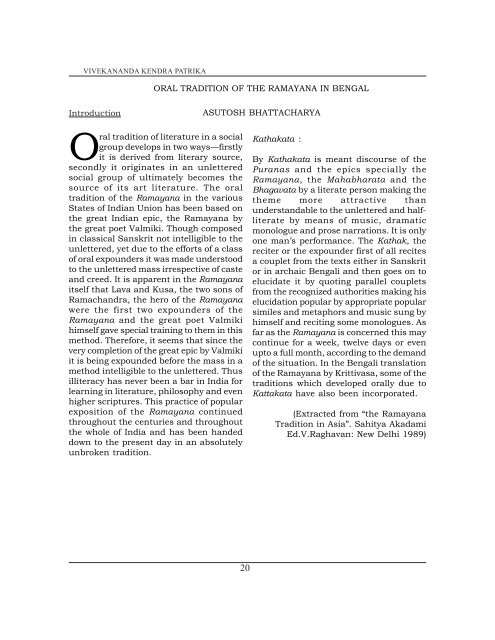Epics in Imprints-1.pdf - Vivekananda Kendra Prakashan
Epics in Imprints-1.pdf - Vivekananda Kendra Prakashan
Epics in Imprints-1.pdf - Vivekananda Kendra Prakashan
Create successful ePaper yourself
Turn your PDF publications into a flip-book with our unique Google optimized e-Paper software.
VIVEKANANDA KENDRA PATRIKA<br />
Introduction<br />
ORAL TRADITION OF THE RAMAYANA IN BENGAL<br />
Oral tradition of literature <strong>in</strong> a social<br />
group develops <strong>in</strong> two ways—firstly<br />
it is derived from literary source,<br />
secondly it orig<strong>in</strong>ates <strong>in</strong> an unlettered<br />
social group of ultimately becomes the<br />
source of its art literature. The oral<br />
tradition of the Ramayana <strong>in</strong> the various<br />
States of Indian Union has been based on<br />
the great Indian epic, the Ramayana by<br />
the great poet Valmiki. Though composed<br />
<strong>in</strong> classical Sanskrit not <strong>in</strong>telligible to the<br />
unlettered, yet due to the efforts of a class<br />
of oral expounders it was made understood<br />
to the unlettered mass irrespective of caste<br />
and creed. It is apparent <strong>in</strong> the Ramayana<br />
itself that Lava and Kusa, the two sons of<br />
Ramachandra, the hero of the Ramayana<br />
were the first two expounders of the<br />
Ramayana and the great poet Valmiki<br />
himself gave special tra<strong>in</strong><strong>in</strong>g to them <strong>in</strong> this<br />
method. Therefore, it seems that s<strong>in</strong>ce the<br />
very completion of the great epic by Valmiki<br />
it is be<strong>in</strong>g expounded before the mass <strong>in</strong> a<br />
method <strong>in</strong>telligible to the unlettered. Thus<br />
illiteracy has never been a bar <strong>in</strong> India for<br />
learn<strong>in</strong>g <strong>in</strong> literature, philosophy and even<br />
higher scriptures. This practice of popular<br />
exposition of the Ramayana cont<strong>in</strong>ued<br />
throughout the centuries and throughout<br />
the whole of India and has been handed<br />
down to the present day <strong>in</strong> an absolutely<br />
unbroken tradition.<br />
ASUTOSH BHATTACHARYA<br />
20<br />
Kathakata :<br />
By Kathakata is meant discourse of the<br />
Puranas and the epics specially the<br />
Ramayana, the Mahabharata and the<br />
Bhagavata by a literate person mak<strong>in</strong>g the<br />
theme more attractive than<br />
understandable to the unlettered and halfliterate<br />
by means of music, dramatic<br />
monologue and prose narrations. It is only<br />
one man’s performance. The Kathak, the<br />
reciter or the expounder first of all recites<br />
a couplet from the texts either <strong>in</strong> Sanskrit<br />
or <strong>in</strong> archaic Bengali and then goes on to<br />
elucidate it by quot<strong>in</strong>g parallel couplets<br />
from the recognized authorities mak<strong>in</strong>g his<br />
elucidation popular by appropriate popular<br />
similes and metaphors and music sung by<br />
himself and recit<strong>in</strong>g some monologues. As<br />
far as the Ramayana is concerned this may<br />
cont<strong>in</strong>ue for a week, twelve days or even<br />
upto a full month, accord<strong>in</strong>g to the demand<br />
of the situation. In the Bengali translation<br />
of the Ramayana by Krittivasa, some of the<br />
traditions which developed orally due to<br />
Kattakata have also been <strong>in</strong>corporated.<br />
(Extracted from “the Ramayana<br />
Tradition <strong>in</strong> Asia”. Sahitya Akadami<br />
Ed.V.Raghavan: New Delhi 1989)

















